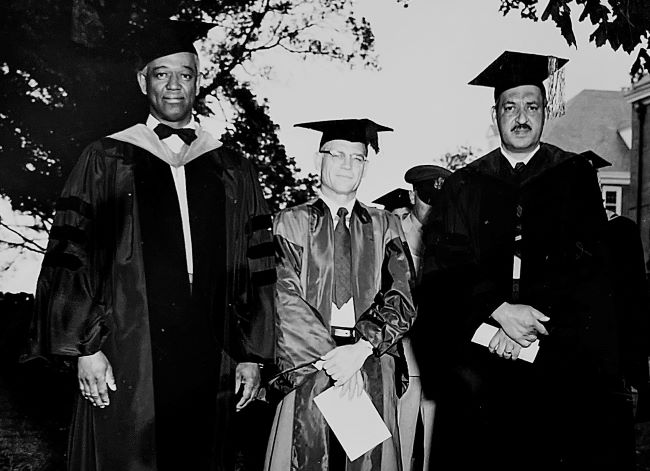Three years removed from his victory as lead counsel in the landmark desegregation case Brown vs. the Board of Education of Topeka, Kan., Thurgood Marshall was Maryland State College’s commencement speaker in the spring of 1957.

While Marshall built an impressive resume fighting discrimination as a civil rights attorney for the NAACP, he cemented his legacy as one of the 20th century’s most influential Blacks when he was appointed to serve on the U.S. Supreme Court in 1967.
The job of lobbying Marshall to come to Princess Anne fell to the Rev. William Tycer Nelson, a colorful Maryland State instructor and campus chaplain. Nelson had an unparalleled network of contacts he used to recruit some of the country’s most influential Black civic and cultural leaders to the small land-grant institution on the lower Eastern Shore.
Maryland State was not unfamiliar to Marshall. A Baltimore native, he graduated from Howard University School of Law because his hometown law school would not admit him. Marshall subsequently represented Donald G. Murray, who won a 1935 lawsuit challenging the University of Maryland’s law school admission policy as discriminatory. Earlier that year, Murray got a rejection letter that read, in part, “under the general laws of this State, the University maintains the Princess Anne Academy as a separate institution of higher learning for Negroes.”

In Feb. 27, 1957 correspondence with Nelson, Marshall wrote, “I will be more than happy to visit the Eastern Shore again and hope that what I have to say will be of some help to all concerned.”
Two days before delivering his commencement remarks, the local daily newspaper noted that as the NAACP’s chief legal officer, Marshall won 11 cases of 13 cases he had argued before the Supreme Court. There was no mention of the Brown decision.
Among those on hand May 30 for graduation was Dr. Wilson H. Elkins, three years into a 24-year tenure as leader of the University of Maryland, which at the time had administrative oversight of the Princess Anne campus. According to alumni records, 57 Maryland State students that day were eligible to receive degrees.
In the following day’s newspaper, Marshall, then 48, was quoted as telling graduates: “the child that is born the blackest, poorest, most underprivileged sharecropper in Mississippi merely by drawing its first breath of democratic air is automatically endowed with the same rights as John D. Rockefeller’s child.”
“I don’t feel sorry for the Negro in the South today,” the newspaper quoted Marshall as saying. “I feel sorry for the white man in the South who allows a few people to dictate policies he himself knows are wrong. People are afraid to speak out what is in their minds.”
A stone’s toss from the venerable auditorium where Marshall delivered those remarks was Somerset Junior-Senior High School*, which the county government opened in early 1954 specifically for Blacks just months before the Supreme Court issued its public school desegregation decision. Six days after Marshall appeared at Maryland State, 34 Black students became Somerset High alumni.
(*) The segregated secondary school was acquired from local authorities after Somerset County public schools were integrated in the late 1960s and is known as Kiah Hall on the University of Maryland Eastern Shore campus.

